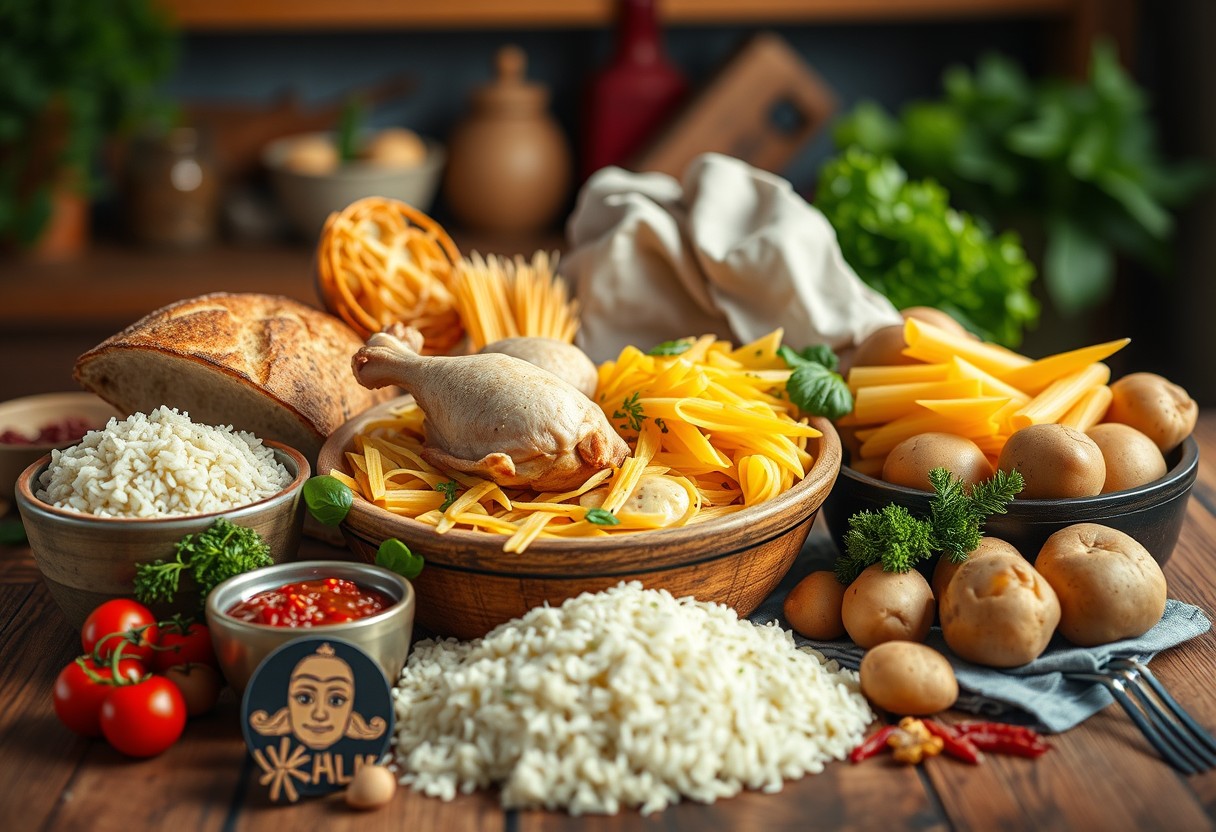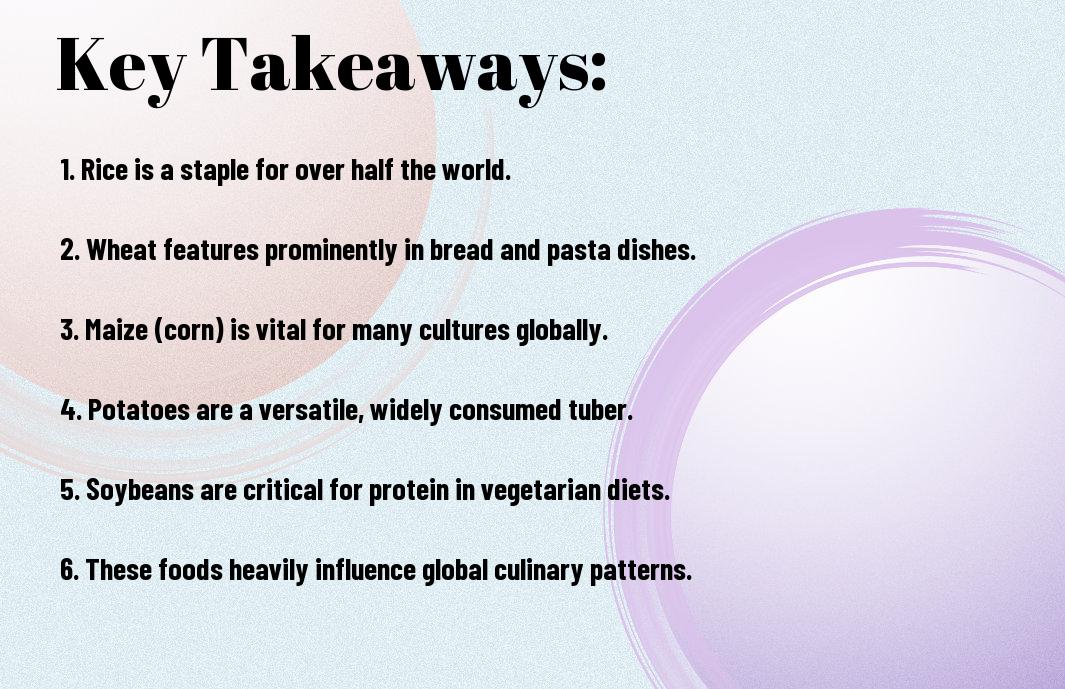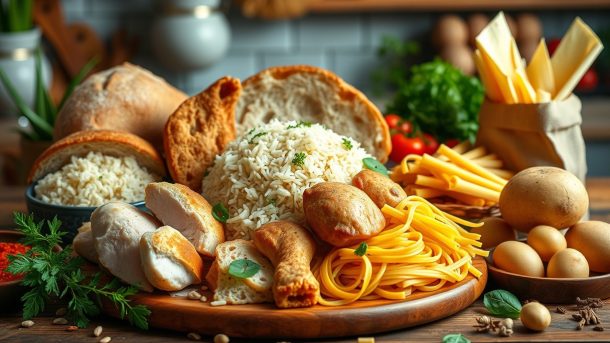Eaten across cultures and continents, certain foods dominate our diets worldwide. You might be surprised to discover which foods top the list of global consumption. Understanding these staples can provide insight into dietary trends and preferences that shape our culinary experiences. In this post, you’ll learn about the top five most eaten foods that have become imperative to your meals. For more information, you can check the Report: These Are The Most Eaten Foods in the World, 2023.
Key Takeaways:
- Rice: This staple food is consumed by more than half of the world’s population and is a primary source of carbohydrates in many regions.
- Wheat: Integral in various forms like bread, pasta, and noodles, wheat is the second most consumed grain globally, playing a crucial role in various cuisines.
- Meat: Particularly poultry, pork, and beef, meat remains one of the top sources of protein worldwide, with consumption patterns varying widely by culture.
Rice
The staple food for more than half of the world’s population, rice comes in many varieties and is cultivated in various climates. Rich in carbohydrates and a source of several important nutrients, rice plays a fundamental role in the diets of people around the globe.
Nutritional Value
Nutritional value of rice can vary depending on the type, but generally, it serves as a good source of energy. Brown rice offers more fiber, vitamins, and minerals compared to white rice, which has been milled to remove the bran and germ. You can enhance the nutritional profile of your meals by incorporating whole grain rice options.
Global Consumption Trends
Nutritional studies indicate that rice remains one of the most consumed grains worldwide, with Asia leading in production and consumption. As populations continue to grow, the demand for rice is expected to rise, compelling nations to innovate agricultural practices to ensure sufficient supply.
Global consumption trends show that rice is not just a dietary staple but is also influenced by regional preferences and economic factors. In recent years, you may have noticed a rise in popularity for varieties like basmati and jasmine, reflecting your evolving tastes and culinary interests.
Cultural Significance
For many cultures, rice is more than just food; it holds significant cultural and social importance. From ceremonies to daily meals, rice is often at the heart of various traditions, symbolizing prosperity and fertility.
Significance of rice varies greatly across different cultures. In some places, it is used in rituals or celebrations, while in others, it is a central dish that brings families together. Understanding your own cultural relationship with rice can deepen your appreciation for this versatile grain.
Wheat
Some may not realize that wheat is among the most consumed foods worldwide, forming the basis of countless diets. You can explore more about this topic in the article on the 10 Most Eaten Food In The World (No. 8 Will Surprise You ….
Varieties and Uses
Wheat comes in various types, including hard red, soft red, white, durum, and spelt, each serving distinct culinary purposes. You can find it in staples such as bread, pasta, and pastries, making it one of the most versatile grains available.
Health Benefits
Uses of wheat extend beyond just food; it also offers numerous health benefits. Regular consumption can aid in digestive health, boost energy levels, and provide imperative nutrients like fiber, vitamins, and minerals that your body needs for optimal functioning.
This grain contains vital nutrients, including B vitamins, iron, magnesium, and fiber, which helps in regulating blood sugar levels and supporting a healthy digestive system. By incorporating whole wheat into your diet, you can help maintain a balanced diet and potentially reduce the risk of chronic diseases, making it a valuable addition to your meals.
Economic Impact
An impressive aspect of wheat is its significant economic impact globally. It is a major agricultural commodity that provides livelihoods for millions of farmers and workers, influencing economies from local to international levels.
Impact of wheat cultivation and trade extends far beyond just filling plates; it plays a crucial role in food security and agricultural markets. With its demand constantly growing due to population increase, investing in wheat production promotes economic stability and growth, benefiting both producers and consumers.
Maize (Corn)
Unlike many other food staples, corn serves a multitude of purposes worldwide, from human consumption to industrial applications. It is fundamentally important in various cuisines and as a primary source of energy in animal feeds. Its versatility and adaptability have made it one of the most consumed foods globally.
Different Types of Maize
Different types of maize cater to diverse uses and preferences, enriching diets and industries alike:
| Sweet Corn | Consumed fresh, canned, or frozen, perfect for salads and sides. |
| Flint Corn | Hard, glassy kernels, traditionally used for decoration and hominy. |
| Dent Corn | Commonly used for animal feed, snacks, and cornmeal. |
| Popcorn | Variety that expands and puffs when heated, popular snack. |
| White Corn | Used primarily in tortillas and cornmeal, mild flavor. |
- Recognizing the variety of maize is important in understanding its wide-ranging significance.
Role in Animal Feed
One of the most critical functions of corn is its use as a primary ingredient in animal feed. As an energy-dense grain, corn supports the growth and health of livestock, contributing to the efficiency of meat, dairy, and egg production.
Role in animal feed extends beyond just energy provision. The nutrient-rich profile of corn, including carbohydrates, vitamins, and minerals, plays a vital role in promoting animal health. Additionally, its availability and affordability make it the go-to choice for farmers worldwide, ensuring that livestock can thrive and produce quality food products for consumers.
Influence on Global Cuisine
Role of maize in global cuisine cannot be overstated. It serves as a fundamental ingredient in numerous dishes, influencing culinary traditions from the Americas to Africa and Asia.
A variety of meals, from tortillas in Mexico to polenta in Italy, showcase the versatility of corn. Its presence transcends cultural boundaries, making it not only a staple for sustenance but a vital component of numerous ethnic dishes that bring communities together and highlight regional agricultural practices.
Potatoes
After centuries of cultivation, potatoes have become an crucial part of diets worldwide. Originating in the Andean region of South America, they were brought to Europe by Spanish explorers in the late 16th century. Potatoes quickly gained popularity due to their adaptability in various climates and their rich nutritional content, becoming a staple in many countries
Historical Background
On their arrival in Europe, potatoes were initially met with skepticism, often regarded with suspicion as food for the poor. However, their nutritional value soon became apparent, leading to their widespread adoption. Over the centuries, potatoes have played a significant role in global food security, contributing to population growth and preventing famine.
Versatility in Cooking
The versatility of potatoes makes them a beloved ingredient in kitchens around the world. They can be prepared in countless ways, including boiling, baking, frying, and mashing, allowing them to shine in various cuisines. You can enjoy a comforting bowl of mashed potatoes, crispy French fries, or a hearty potato soup, making them a staple for both simple and elaborate meals.
To truly appreciate the versatility of potatoes, consider their ability to complement a wide range of flavors and dishes. Whether you opt for classic potato salad, savory gratin, or spicy potato curry, these humble tubers can be tailored to suit your taste preferences. Their ability to absorb flavors and textures makes them an ideal base for a myriad of culinary creations, proving that potatoes are something you can never tire of.
Potential Health Risks
One important aspect to consider when incorporating potatoes into your diet is the potential health risks associated with their consumption. While they offer a wealth of nutrition, some cooking methods or excessive consumption can lead to health concerns, such as weight gain or increased blood sugar levels if eaten in large quantities.
Risks also arise from certain cooking methods, such as frying, which can significantly increase calorie and fat content. Moreover, the glycemic index of potatoes can contribute to spikes in blood sugar, particularly for those managing diabetes. Therefore, it’s crucial to balance your potato intake with other nutrient-rich foods and prefer healthier cooking options like baking or boiling to mitigate these risks.

Soybeans
For centuries, soybeans have become a staple in diets worldwide due to their versatility and nutritional benefits. As one of the most widely consumed legumes, they play a crucial role in both human diets and agriculture.
Nutritional Profile
Profile-wise, soybeans are abundant in protein, offering about 36 grams per cup, making them a vital source of plant-based protein for you. They are also rich in dietary fiber, vitamins, and crucial minerals like iron and calcium, supporting overall health and wellness.
Uses in Food Products
One of the remarkable aspects of soybeans is their plethora of uses in food products, serving as a base for various items. Whether you enjoy tofu, soy milk, tempeh, or soy sauce, you are likely benefiting from this versatile legume.
Food derived from soybeans offers numerous nutritional benefits and caters to diverse culinary traditions. You may consume soybeans directly or in processed forms, which provide a plant-based protein alternative that’s increasingly popular among vegetarians and vegans. The versatility of soy products allows them to be incorporated into everyday meals, highlighting their importance in global cuisines.
Environmental Considerations
Nutritional benefits aside, it’s crucial to consider the environmental impact of soybean production. High demand for soy can lead to deforestation and habitat loss, which significantly affects biodiversity and ecosystems.
Plus, sustainable farming practices and mindful consumption of soy products can mitigate negative environmental effects. As a conscious consumer, you can opt for certified organic or sustainably sourced soy products, helping to preserve natural resources while enjoying the benefits of this nutritious legume.

Summing up
Upon reflecting on the top five most consumed foods globally, you can appreciate the widespread appeal and nutritional value they offer. Rice, wheat, maize, potato, and soybeans dominate diets across cultures and regions, providing crucial calories and nutrients for billions. Understanding these staples helps you acknowledge the diverse culinary practices that exist and the importance of these foods in sustaining populations worldwide. By recognizing their significance, you enhance your appreciation for global food systems and the role these staples play in your own diet.
FAQ
Q: What are the top 5 most eaten foods globally?
A: The top 5 most eaten foods worldwide include rice, wheat, maize (corn), potatoes, and chicken. These foods are staples in many diets and play a crucial role in global food security.
Q: Why is rice considered one of the most consumed foods?
A: Rice is a staple food for more than half of the world’s population, especially in Asia. Its high carbohydrate content, versatility in cooking, and ability to grow in various climates contribute to its widespread consumption.
Q: How does wheat rank among the most eaten foods?
A: Wheat is the most widely cultivated cereal grain and is a primary ingredient in bread, pasta, and many baked goods. Its popularity is due to its adaptability in different climates and its role as a major source of energy and nutrients in many diets.
Q: What makes maize (corn) a top food source?
A: Maize is not only a staple food in many countries but also serves various purposes including animal feed, corn syrup, and biofuel. Its ability to adapt to various environmental conditions and its high yield make it a crucial crop globally.
Q: Why are potatoes included in the list of top foods consumed?
A: Potatoes are one of the most versatile and nutrient-rich foods, rich in carbohydrates, fiber, and vitamins. They can be prepared in numerous ways and are grown in many regions, making them a staple for many cultures.
Q: How has chicken become one of the most consumed meats worldwide?
A: Chicken is favored for its affordability, versatility, and lower fat content compared to other meats. It can be prepared in countless ways, making it a popular choice for households across different cultures around the world.


